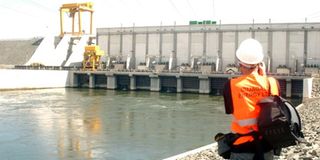Power outages persist despite better supply

Bujagali Electricity Limited is contracted to run the Bujagali Hydro Power plant, which was commissioned in 2012. FILE PHOTO
What you need to know:
Volume. The generation capacity has increased from 380MW to 852MW.
Kampala. Ten years after Uganda experienced its worst electricity generation crisis, which has since been addressed, electricity users now have to contend with power outages.
During the power crisis, Uganda was generating 140MW against peak demand of 180MW.
Then, the country was relying on the Owen Falls Dam hydropower plant, which uses water from Lake Victoria, to generate electricity.
But the lake’s water level had dropped from 12.88 metres to 10.40 metres as of October 2006, according to a brief to the Cabinet by Energy minister Irene Muloni.
According to Mr Daniel Hull, a hydrologic engineer, the drop was due to both the drought in 2004 and construction of another dam parallel to the Owen Falls.
Given the low lake water levels, hydropower production inevitably reduced.
Electricity users would thereafter have electricity for 12 hours in a day.
“Because of load shedding, I was milling two to three tonnes, down from ten tonnes daily,” says Patrick Busobozi, a maize miller in Rubaga.
To address the power supply crisis, the government roped in independent thermal diesel electricity generation companies Agrekko, Electromaxx and Jacobsen to reduce on the outages. These added a total of 170MW to the national grid.
But suppressed demand was increasing by an estimated 50MW annually on the back of increasing connections of houses and factories to the national grid.
Government could not bring in more thermal diesel plants because each unit of electricity from the thermal plants cost between $0.22 (Shs765.82) and $0.30 (Shs1,044.3).
The retail power tariff for millers like Mr Richard Sserwadda, also a maize miller in Rubaga, increased from Shs194.46 in 2005 to Shs294.17 per unit in 2006.
In 2006, though the thermal plants produced only 23 per cent of the electricity generated in Uganda, they gobbled 73 per cent of the electricity sector’s Shs420 billion-revenue requirement.
And by 2011, the government had spent Shs1.5 trillion on the thermal plants to subsidise the retail tariff of electricity.
Shs1.5 trillion could have financed the building of a 600MW hydropower plant.
The government scrapped the subsidies in 2011, saying they were not sustainable, just months after commissioning the 250MW Bujagali Hydropower Plant.
End-user tariffs for domestic consumers were soon after increased from Shs282.87 to Shs395.27 per unit.
Domestic consumers now pay Shs651 a unit.
When President Museveni finally commissioned Bujagali in 2012, load shedding reduced from 12 hours to two hours daily.
The chief executive officer of the Electricity Regulatory Authority (ERA), Dr Benon Mutambi, says over the last 10 years, their main concern was on how to meet the suppressed demand for power.
“We now have enough spinning reserve. We want to make sure the situation does not turn for the worse,” Dr Mutambi said.
Load shedding has reduced because generation capacity has since increased from 380MW to 852MW. Between 2009 and 2011, in the face of increasing suppressed demand for power, ERA in liaison with development partners offered incentives to encourage private investors to establish power plants. They guaranteed generation companies feed-in-tariffs and in some cases topped them up.
According to Eskom Uganda Limited technical director Brian Mushimba, Lake Victoria’s water level has since risen to 12 metres. Eskom (U) has been operating and maintaining the Kiira and Nalubaale hydropower stations since 2003.
The two plants contribute 37.5 per cent of the electricity on the national grid.
Though they have an installed generation capacity of 380MW, they currently dispatch not more than 250MW.
This is because the Uganda Electricity Transmission Company Limited has to buy power from up to 14 electricity generation companies.
If it does not buy power from some, it would still have to pay capacity charges, which in the case of the thermal diesel plants is Shs68 billion annually – as the Auditor General John Muwanga pointed out in the December 2015 report.
Hoima Municipality parliamentary candidate Lawrence Bategeka said much as power generation has been addressed, inefficiencies in the distribution and transmission systems need to be fixed; citing the incessant power outages and energy losses - now at 20 per cent, in the case of distributor Umeme.
Outages explained
Of late, there are outages every other day in different parts of the country.
Through a social networking site, Facebook, Umeme’s media manager Stephen Ilungole attributed the outages to vandalism of the distribution assets and system faults on the distribution network.




